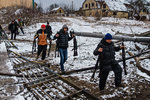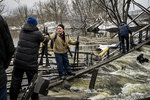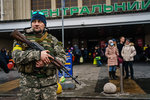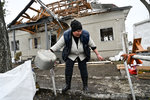




KYIV, Ukraine — Russian forces continued to batter targets in Ukraine on Tuesday, striking government buildings, a television tower and the country’s main Holocaust memorial, and assembling a 40-mile-long column of tanks, artillery and other military vehicles outside the capital, Kyiv, in what could be a sign of an imminent assault.
The specter of more violence and the scenes of civilians huddled in bomb shelters or pouring across Ukraine’s western borders come as Russia finds itself increasingly isolated on the world stage, with sanctions inflicting immediate damage to its economy and currency. The United Nations’ refugee agency reported that 660,000 people have fled Ukraine in the last six days — a rate that puts the situation on track to “become Europe’s largest refugee crisis this century,” agency spokesperson Shabia Mantoo said in Geneva.
Ukrainian defense officials said at least five people were killed in Kyiv when Russian bombs hit the nation’s main TV tower, disrupting programming. They also reported a “powerful missile attack” near the Babi Yar Holocaust memorial, which marks the site where nearly 34,000 Jews were killed within 48 hours in 1941 when the city was under Nazi occupation.
In Kharkiv, the nation’s second-largest city, a missile slammed into a central city square in front of a large, ornate government building, the Ukrainian Interior Ministry said. Video of the explosion was shared widely on social media, showing cars engulfed in flames.
The Ukraine State Emergency Service said 10 people were killed and 24 wounded in the strike on Freedom Square, the site of Kharkiv’s regional government headquarters. An opera house and concert hall nearby were also hit.
The blast came after a barrage of what observers say might have been cluster bombs on a residential neighborhood Monday evening, killing at least nine civilians and wounding dozens of others in Kharkiv, a city of 1.4 million in northeastern Ukraine. President Volodymyr Zelenskyy condemned the attack as “state terrorism.”
Ukrainian authorities also confirmed reports that about 70 Ukrainian soldiers were killed in a Russian attack on a military base in the town of Okhtyrka, west of Kharkiv, on Sunday. And several people were wounded in strikes Tuesday on the southeastern port city of Mariupol, The Associated Press reported.
The bombardments hint at a new, more violent phase in a Russian incursion that appeared to have partly stalled in the face of dogged resistance and possible logistical problems, such as a shortage of food and fuel.
A senior Pentagon official said Tuesday that there are signs that Russian troops may be losing morale, and said some have surrendered without a fight.
“They’re not only running out of gas, but they are running out of food,” said the official, who spoke on the condition of anonymity. Yet Russia has been unrelenting in its bombardments, with the official saying more than 400 Russian-launched missiles had hit Ukraine as of Tuesday.
Civilian casualties are mounting, as are fears of increased airstrikes and suspicions that Russian President Vladimir Putin will order his troops to encircle and blockade major population centers such as Kyiv and Kharkiv, bombing or starving them into submission.
“What we see now see is a new wave of attack against Ukraine, against innocent people,” NATO Secretary-General Jens Stoltenberg said at a news conference in Estonia on Tuesday. “And a column of heavy Russian armor which is moving towards Kyiv will bring more death, more suffering and more civilian casualties.”
Speaking virtually at the opening session of this year’s U.N. Human Rights Council meeting in Geneva on Tuesday, Secretary of State Antony J. Blinken blasted Moscow for its “mounting” human rights abuse and violation of international law.
“Russian strikes are hitting schools, hospitals and residential buildings,” Blinken said. “They are destroying critical infrastructure, which provides millions of people across Ukraine with drinking water, gas to keep them from freezing to death, and electricity. Civilian buses, cars, and even ambulances have been shelled. ”
Later in Monday’s U.N. meeting, Russian Foreign Minister Sergey Lavrov spoke, also via video conference. He launched into an angry speech justifying Russia’s invasion of Ukraine, blaming the neighboring former Soviet republic for atrocities against ethnic Russians in eastern Ukraine. And he claimed, with no evidence, that Kyiv was trying to secure nuclear weaponry.
Representatives of dozens of countries rose to their feet, turned their backs on Lavrov as he spoke, and walked out of the room.
The German representative, Katharina Stasch, accused Lavrov of a “cynical distortion of the facts,” according to the German news agency DPA.
Lavrov had planned to attend the meeting in person — but couldn’t travel because most of Europe has closed its airspace to Russian aircraft, as part of a battery of sanctions the West and others have imposed to punish Moscow.
Talks on Monday between Ukraine and Russia failed to bring the cease-fire that Kyiv demanded. More negotiations are in the offing, but Zelenskyy has expressed skepticism of any breakthrough, saying he agreed to talks only to show that he was shunning no opportunity to try to restore peace.
As the invasion stretched into its sixth day, residents of Kyiv braved freezing temperatures and trudged through snow Tuesday to line up outside supermarkets, gas stations and even the small coffee kiosks that dot the sidewalks here to stock up before a Russian assault.
Throughout the capital there were signs of a city hunkering down. Makeshift checkpoints sprang up overnight in greater numbers than before. Reservists dressed in civilian clothing — some of them young men who appeared to be barely out of high school — wrapped yellow armbands around their sleeves. Wielding guns, they manned hastily assembled barriers of tires, trash bins and other detritus and stopped motorists to check their cars.
To the northwest of the city, closer to Russian positions, traffic was almost nonexistent; even the large neighborhood supermarket had no lines. Soldiers shooed away anyone approaching, warning them that Russian artillery fire had started up.
Moments later, a blast hit nearby, reverberating across the tall birch forests on the side of the highway.
Vadym Prystaiko, Ukraine’s ambassador to London, told British lawmakers that Ukrainian troops still maintained control of the western approach to Kyiv and the western part of the country, which is vital to keep the capital from being strangled by Russian forces. He said Ukraine’s military had 200 tanks and 700 trucks to help defend the country and keep supply routes open.
But the massive convoy of Russian armored vehicles to the north of Kyiv, which satellite images showed stretching for 40 miles, augured a major assault.
On Tuesday afternoon, the Russian Defense Ministry issued a warning, carried by the news agency Tass, that its forces would be launching “high-precision weapons” at a facility belonging to the Security Service of Ukraine and an information and psychological operations center in Kyiv, “in order to suppress information attacks against Russia.” The statement warned residents in the area to leave their homes.
“They want to break our nationhood — that’s why the capital is constantly under threat,” Zelenskyy said in a video address late Monday, adding that Kyiv was hit by three missile strikes Monday and that hundreds of Russian saboteurs were roaming the city.
A host of Western nations, including most recently Australia, have agreed to supply Ukraine with military aid. But they have rebuffed calls to impose a NATO-led no-fly zone over Ukraine because of the risk of starting a much larger war.
“Unfortunately the implication of that is that the U.K.” — and other nations — “would be engaged in shooting down Russian planes,” British Prime Minister Boris Johnson said in Warsaw. “It would be engaged in direct combat with Russia. That’s not something that we can do or that we’ve envisaged. ... The consequences of that would be truly very, very difficult.”
Both Kyiv and Kharkiv, as Ukraine’s two most populous cities, hold enormous symbolic significance and are therefore prime targets, said Prystaiko, the ambassador, pointing to the historical example of the Bolshevik revolution in Russia more than a century ago.
“They are using the same textbook they used from 1918 when they couldn’t take Kyiv,” Prystaiko said. “They took Kharkiv” and proclaimed the Ukrainian People’s Republic, with Kharkiv as its capital. Then, “as soon as Kyiv fell, they moved the capital back to Kyiv. So I believe that that’s one of the scenarios [now].”
Johnson, following a meeting with the Polish premier, said that the West was prepared to intensify its sanctions on Moscow to punish it for “unfolding disaster in our European Continent.”
“I say to Vladimir Putin and his regime: There is only one way out of this morass, and that is to stop the tanks, to turn back the tanks, on their way to Kyiv — turn them round and take the path to peace,” Johnson said.
On Monday, Zelenskyy said he had officially signed an application for Ukraine’s membership in the European Union.
Appearing by video in an address to the European Parliament early Tuesday afternoon, he passionately campaigned for Ukraine to be let into the 27-nation club, although accession is a distant prospect.
“We are fighting also to be equal members of Europe,” Zelenskyy said. “I believe that today we are showing everybody that is what we are. ... We have proven that, at a minimum, we are the same as you.”
____
(Bulos reported from Kyiv, Linthicum from Mexico City and Wilkinson from Washington. Los Angeles Times staff writers Anumita Kaur in Washington and David Pierson in Singapore contributed to this report.)
___
©2022 Los Angeles Times. Visit at latimes.com. Distributed by Tribune Content Agency, LLC.